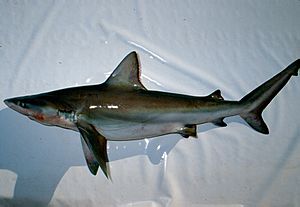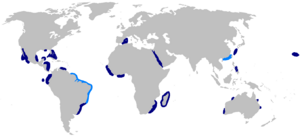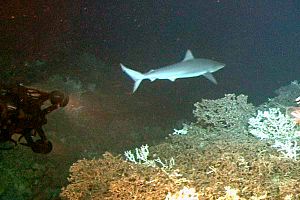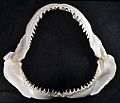Bignose shark facts for kids
Quick facts for kids Bignose shark |
|
|---|---|
 |
|
| Conservation status | |
| Scientific classification | |
| Genus: |
Carcharhinus
|
| Species: |
altimus
|
 |
|
| Confirmed (dark blue) and suspected (light blue) range of the bignose shark | |
| Synonyms | |
|
Carcharhinus radamae Fourmanoir, 1961 |
|
The bignose shark (Carcharhinus altimus) is a large shark. It is also known as the Knopp's shark. This shark is part of the Carcharhinus group, which includes many types of sharks. Bignose sharks can grow quite big. They can reach up to 9.8 feet (3 metres) in length. They can also weigh as much as 370 pounds (168 kg).
You can find these sharks in warm, tropical, and subtropical parts of the world. They usually live along the edges of continental shelves. They also live on the slopes of islands. They prefer deep waters, sometimes as deep as 1,410 feet (430 metres).
Contents
What Does a Bignose Shark Look Like?
The bignose shark is a big, slender shark. It has a long, wide snout that is a bit blunt. This is how it got its name, "bignose." It has clear flaps on its nose. These flaps are easy to see.
This shark has a high ridge between its two dorsal fins. This ridge is very noticeable. Its pectoral fins are long and straight. The first dorsal fin has a blunt tip. It is located above or just behind the pectoral fins. The anal fin is slightly behind the second dorsal fin.
Bignose sharks look a bit like Night sharks. But you can tell them apart. The night shark's second dorsal fin has a long, free rear tip. It is at least twice as long as the fin's height. The bignose shark's second dorsal fin has a much shorter tip.
Bignose sharks are usually grey. They do not have many markings. Their underside is white. Their pectoral fins have black tips. The tips of most other fins are dusky, except for the pelvic fins. Sometimes, freshly caught sharks have a green shade near their gills.
Newborn bignose shark pups are about 2 to 3 feet (60 to 90 cm) long. Male sharks become adults when they are about 7.1 feet (2.2 metres) long. Females become adults when they are between 7.4 and 9.3 feet (2.3 and 2.8 metres) long.
Where Do Bignose Sharks Live?
Bignose sharks live in warm, tropical, and subtropical areas. In the western Atlantic Ocean, they are found from Florida in the United States down to Venezuela. In the eastern Atlantic, they live from Senegal to Ghana. They are also found in the Mediterranean Sea.
In the western Indian Ocean, they have been seen near the Red Sea, Mozambique, South Africa, Madagascar, and India. In the Pacific Ocean, you can find them off China and Hawaii. They also live in the Gulf of California, Mexico, Colombia, and Ecuador.
These large sharks live offshore. They stay near the edges of continental shelves and island slopes. They can be found from close to the surface down to 1,410 feet (430 metres) deep. Adult sharks often swim deeper than 295 feet (90 metres). Younger sharks prefer shallower waters.
How Do Bignose Sharks Reproduce?
Bignose sharks are viviparous. This means they give birth to live young, just like humans. They do not lay eggs. A mother bignose shark can have 3 to 11 pups in one litter. These pups are usually 60 to 90 cm long when they are born.
Male bignose sharks are ready to have babies when they are about 2 metres long. Females are ready when they are between 2.3 and 2.8 metres long. Females give birth at different times of the year. This depends on where they live. For example, in the Mediterranean Sea, they give birth from August to September. Off the coast of Madagascar, births happen in September and October.
What Do Bignose Sharks Eat?
The bignose shark mainly eats fish and other sea creatures that live near the bottom of the ocean. They eat bony fish like lizardfish, croakers, flatfish, mackerels, and soles. They also eat cartilaginous fish. These include dogfish (like Squalus), catsharks, stingrays, and chimaeras. Besides fish, they also eat cephalopods, which are creatures like squid and octopuses.
Other Names for the Bignose Shark
In English, the bignose shark is also known as the "Knopp's shark." People in other countries have different names for it. For example, in Spanish, it's called "Baboso" or "Tiburón narizón." In Afrikaans, it's "Grootneushaai." In Dutch, it's "Grootsnuithaai." Other names include "Marracho baboso" in Portuguese and "Requin babosse" in French.
Bignose Sharks and Humans
Bignose sharks are sometimes caught by large fishing boats called trawlers. They are also rarely caught with hooks and lines. In the Caribbean region, they are caught using longlines. Their meat is used for fish meal, which feeds animals. Their oil is also used.
In U.S. waters, it is against the law to catch bignose sharks for commercial fishing. Even though these sharks are large, they usually do not bother humans. This is because they live in very deep waters, far from where people swim.
How Are Bignose Sharks Protected?
The bignose shark's conservation status is "Data Deficient" in most places. This means we do not have enough information about their populations. We need more data on how many there are and how fishing affects them. However, in Australia, they are listed as "Least Concern" by the IUCN. This means they are not currently at risk there.
The fishing of bignose sharks is managed in U.S. waters. The National Marine Fisheries Service sets rules for it. As mentioned, it is forbidden to catch bignose sharks in U.S. waters. If a bignose shark is accidentally caught, it must be put back into the water right away. This helps to make sure the shark has the best chance to survive.
Images for kids
See also
 In Spanish: Tiburón de hocico grande para niños
In Spanish: Tiburón de hocico grande para niños










